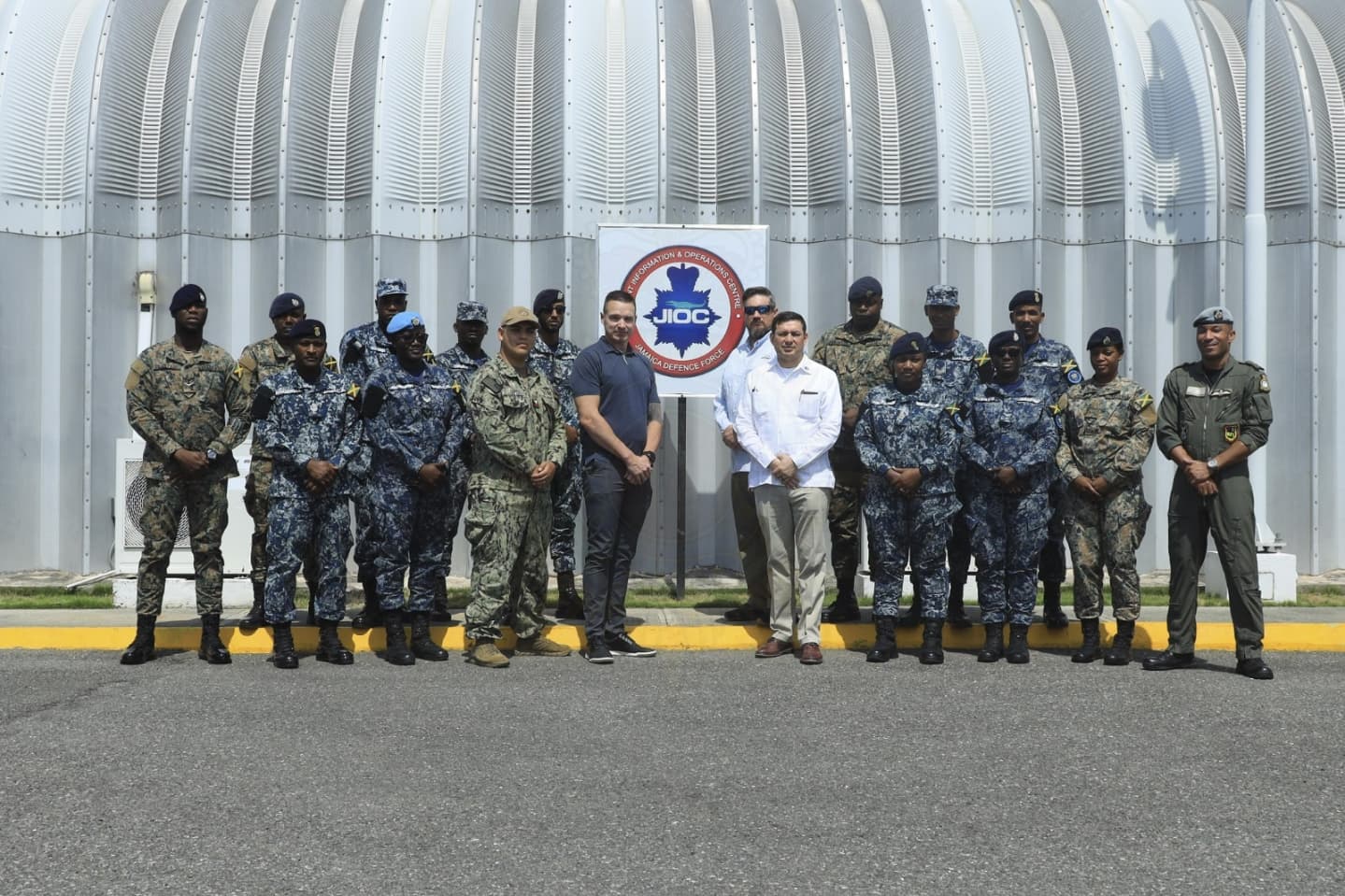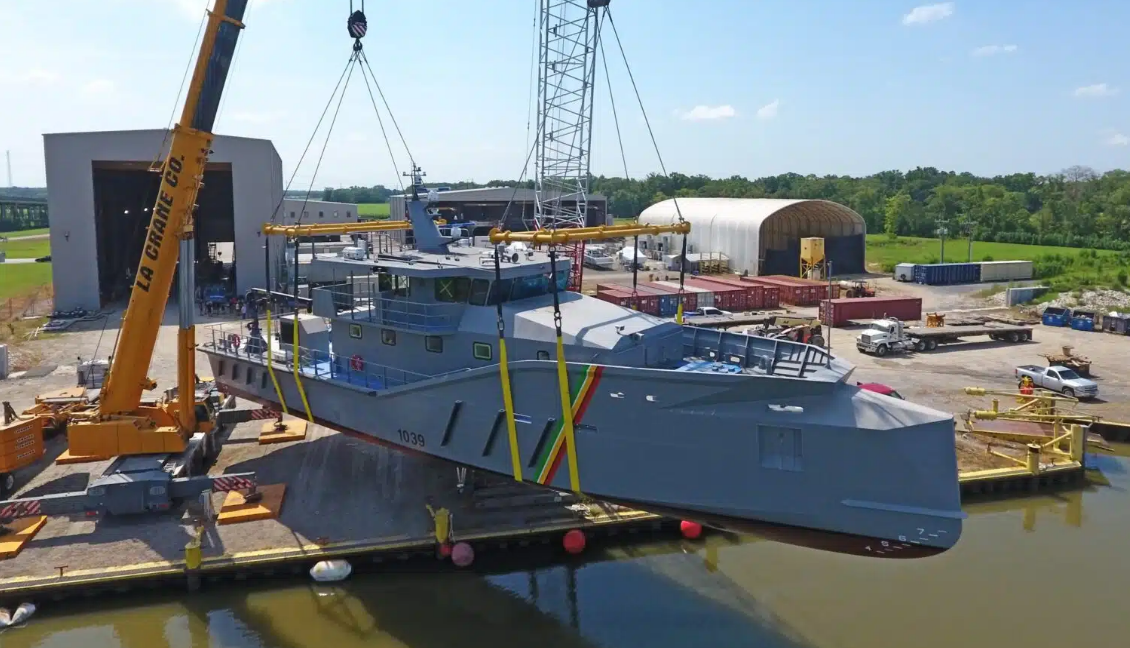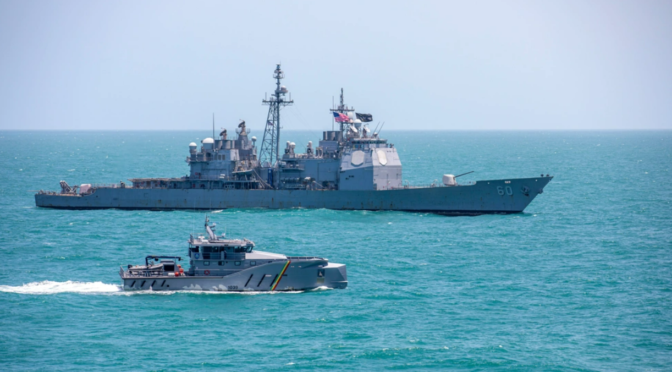By Wilder Alejandro Sánchez
Written by Wilder Alejandro Sanchez, The Southern Tide addresses maritime security issues throughout Latin America and the Caribbean. It discusses the challenges regional navies face including limited defense budgets, inter-state tensions, and transnational crimes. It also examines how these challenges influence current and future defense strategies, platform acquisitions, and relations with global powers.
In late March, the U.S. Navy cruiser USS Normandy (CG 60) and the Guyanese patrol vessel Shahoud carried out joint exercises in Guyana’s exclusive economic zone and international waters. Washington has many allies and partners across the Greater Caribbean, particularly among the region’s English-speaking nations. Despite having limited budgets and assets, the defense forces of the English-speaking Caribbean are training and increasing their capabilities to carry out missions, which aligns with US diplomatic and military objectives.
Ongoing Dialogue
The good news is that high-level interactions between the U.S. military and Caribbean militaries continue. U.S. Navy Admiral Alvin Holsey, the Commander of U.S. Southern Command (SOUTHCOM), traveled to Trinidad and Tobago last December to participate in the Caribbean Nations Security Conference (CANSEC) 2024.
In early January, U.S. Coast Guard Vice Admiral Nathan Moore, Commander of the Atlantic Area, visited Barbados and met with Barbados Defence Force Chief of Staff Brigadier Carlos Lovell. The two senior officers discussed further cooperation on common threats, including transnational organized crime and illegal, unregulated, and unreported (IUU) fishing. Subject Matter Experts from the U.S. military traveled to Jamaica in March and visited the Jamaica Defence Force’s Joint Information and Operations Centre.

More recently, Secretary of State Marco Rubio visited Guyana, Jamaica, and Suriname in late March. The tour was a chance to address Caribbean defense and security issues: during his stop in the Jamaican capital, Rubio also met with Trinidad and Tobago Prime Minister Stuart Young and discussed the bilateral security partnership and regional security issues.
Recent Acquisitions by Caribbean Forces
Improving Maritime Domain Awareness (MDA) remains a priority for Caribbean governments and their defense forces. Hence, regional naval forces acquire new surface and aerial assets for these missions. The Royal Bahamas Defence Force (RBDF) has led the way over the past decade via the Sandy Bottom Project, which enabled the acquisition of a fleet of different Damen-made surface vessels, including patrol vessels. The RBDF has also acquired a fleet of drones. Similarly, the Jamaica Defence Force (JDF) has acquired four offshore patrol vessels, also manufactured by Damen, for the JDF Coast Guard; the HMJS Norman Manley arrived in late 2023.
More recently, the Antigua & Barbuda Defence Force (ABDF) Coast Guard announced in late February the commissioning of a new speedboat for the fleet, hull number CG11-1 Swordfish. This acquisition demonstrates Saint John’s commitment to strengthening the ABDF and improving MDA. Suriname’s Navy is now operating the patrol vessel RSS Barracuda (P501), acquired through a lease-to-buy agreement with Damen Shipyard Group. The ship will have “a crucial role in the protection of the maritime area of the country,” explained the Ministry of Defense. (Suriname’s official language is Dutch, not English, but I will mention it nonetheless).
Guyana deserves special attention. In late 2024, Guyana finally received the 115-foot Defiant patrol vessel GDFS Berbice, produced by the U.S. shipyard Metal Shark. Berbice is the new flagship of the Guyana Defence Force (GDF) Coast Guard and will support maritime operations. Given that Guyana has a border dispute with neighboring Venezuela over Guyana’s Essequibo region and oil-rich waters, acquiring new platforms for the GDF is a priority. In fact, in early March, the Venezuelan patrol vessel ABV Guaiqueiri PO-11 entered Guyana’s exclusive economic zone and harassed oil assets operating there. In a statement, the Guyanese government explained that, “The Venezuelan naval vessel communicated threateningly via radio communication that FPSO PROSPERITY was operating in Venezuela’s exclusive economic zone before continuing in a Southwestern direction towards other FPSOs, to which it delivered the same message.” The Venezuelan Ministry of Defense justified the operation, arguing it took place in contested waters.

The U.S. military and coast guard presence in the Caribbean
The U.S. military, particularly SOUTHCOM, its maritime component U.S. Fourth Fleet, and even U.S. Northern Command (with The Bahamas within its area of responsibility) continue to engage Washington’s English-speaking allies throughout the Caribbean. Engagement is not limited to meetings but also bilateral and multinational military training. For example, SOUTHCOM sponsors the annual exercise Tradewinds, specifically designed for the Caribbean – Trinidad and Tobago hosted Tradewinds 2024. Bilateral training occurs when U.S. warships visit the Caribbean. Passing exercises (PASSEX) are fairly common, case in point, at the time of this writing, in late March, the Normandy and the Shahoud carried out joint exercises, including PASSEX, “in international waters and the Guyana Exclusive Economic Zone to exercise communications and interoperability, and practice joint maneuvers,” according to the U.S. embassy in Guyana.
SOUTHCOM remains focused on Humanitarian Assistance/Disaster Relief (HADR) missions across the Caribbean – and the rest of Latin America. The U.S. hospital ship Comfort is often deployed. However, in recent years, the Spearhead-class expeditionary fast transport vessel USNS Burlington (T-EPF 10) has also traveled throughout the Caribbean to assist populations in need. HA/DR operations are already taking place this year.
The Lesser Antilles Medical Assistance Team (LAMAT) 2025, commenced on 24 February, during which U.S. military medical personnel will visit several Caribbean nations. While LAMAT 2025 does not involve vessels, the humanitarian exercise will provide invaluable medical services to the inhabitants of Saint Lucia, Saint Vincent and the Grenadines, Saint Kitts and Nevis, and Guyana. “All involved agree LAMAT’25 is a win-win scenario, benefiting both U.S. military personnel and partner nations. The mission enhances medical readiness and strengthens partnerships while improving healthcare infrastructure in underserved areas,” explained Air Forces Southern, the aerial component of SOUTHCOM.
The U.S. Navy deployed several assets over the past years throughout the Caribbean as regional countries were hit by deadly and destructive natural disasters, such as hurricanes, floods, and earthquakes. (In previous commentaries for CIMSEC, this author suggested that SOUTHCOM deserves a permanently assigned hospital ship.)
As for security operations, U.S. Navy warships, particularly destroyers and littoral combat ships (LCSs), and U.S. Coast Guard cutters regularly patrol the Caribbean Sea to interdict illicit maritime activities, particularly drug trafficking via vessels and the infamous narco-submarines. Recent platforms deployed to the Command’s area of responsibility include the LCS St. Louis and the Arleigh Burke-class guided-missile destroyer USS Thomas Hudner (DDG 116). The U.S. Coast Guard Cutter Valiant unloaded approximately 12,470 pounds (5,656 kilograms) of cocaine in early March at Coast Guard Base Miami Beach, worth an estimated $141.4 million. The contraband was seized thanks to six interdictions in the Caribbean Sea.
Finally, the Caribbean Sea is ideal for testing emerging technologies. At the time of writing, Operation Southern Spear is underway as the U.S. Navy is testing Uncrewed Surface Vessels (USVs). The objective is to test new systems to develop the future U.S. Navy’s hybrid fleet as part of the service’s Project 33.
Discussion and Analysis
Some Greater Caribbean countries have governments that clash with U.S. diplomatic aims, namely Cuba, Nicaragua, and Venezuela. However, the region has many historical and trustworthy U.S. allies and partners. In a recent interview, Belize Defence Force commander Brigadier General Azariel Loria discussed training exercises with SOUTHCOM, including Special Operations Command South (SOCSOUTH) and the Louisiana National Guard via the State Partnership Program. “We are eager to continue joint training exercises focused on countering transnational threats, with the goal of incorporating tactical operations, humanitarian assistance missions, and specialized training on counterterrorism and disaster response,” he said. BG Loria added that the BDF “looks forward to more innovated ways to take our partnership to another level to improve coordination between our land, air, and maritime units.” In other words, the commanding officers of the English-speaking Caribbean defense forces see the U.S. armed forces (including the Coast Guard) as important allies and partners for training and operating together to combat crimes in air, land, and sea. This relationship must not be lost.
The issue of equipment availability and serviceability is an obvious problem within the region. The Caribbean Sea is a large body of water, and Caribbean countries are not one single unified island nation. Depending on the country, each nation can include countless islands, islets, cays and atolls, and a vast maritime territory. Hence, regional naval forces require a fleet of surface vessels and maritime patrol aircraft to properly monitor and command their maritime territory. Certainly, more vessels demand additional expenses like port infrastructure, fuel, ammo, and crew, among other financial considerations, meanwhile defense budgets across the Caribbean remain limited, hamstringing fleets across the Caribbean. However, the examples mentioned in this analysis- the Bahamas and Jamaica acquiring several ships and the more modest acquisitions of Guyana and Antigua & Barbuda- demonstrate civilian authorities’ commitment to assign more budgets for maritime procurement programs.
Unfortunately, the threats of illicit activities and challenges across the Caribbean will remain ever-present. The sea is the preferred corridor for drug trafficking, while IUU fishing and human and weapons smuggling are also constant challenges and threats. An ongoing concern is the crisis in Haiti, which is forcing Haitians to migrate, often via vessels. Moreover, piracy is making a comeback. Last year, there were reports that two Haitian criminal entities, 5 Seconds and Taliban gangs (no relation to the Afghan Taliban), captured the freighter Magalie at Port-au-Prince’s Varreux terminal district, stealing one-sixth of the cargo of rice and took the crewmembers hostage. The situation was resolved when the police stormed the ship. Even though the incident occurred while the ship was docked, the situation in Haiti has become so dire that it now affects maritime shipping.
For the Caribbean, cooperation is the correct answer. Given the threat environment in the Caribbean Sea and limited surface and aerial assets to patrol this vast body of water, strengthening military-to-military relations advances U.S. and Caribbean interests. A lack of sufficient patrol vessels operated by Caribbean coast guards does not mean a lack of willingness to combat maritime crimes. The U.S. government should provide more tools, including a bigger budget for SOUTHCOM. Armed with a bigger budget, SOUTHCOM can expand its low-cost/ high-impact engagements, benefiting all partners across the Caribbean region.
Wilder Alejandro Sánchez is an analyst who focuses on international defense, security, and geopolitical issues across the Western Hemisphere, Central Asia, and Eastern Europe. He is the President of Second Floor Strategies, a consulting firm in Washington, DC, and a non-resident Senior Associate at the Americas Program, Center for Strategic and International Studies. Follow him on X/Twitter: @W_Alex_Sanchez.
Featured Image: CARIBBEAN SEA (Mar. 27, 2025) – The Ticonderoga-class guided-missile cruiser USS Normandy (CG 60) conducts a passing exercise with Guyana Defence Force Defiant-class patrol ship GDSF Shahoud in the Caribbean Sea. (U.S. Navy photo by Mass Communication Specialist 2nd Class Dylan M. Kinee/Released)

